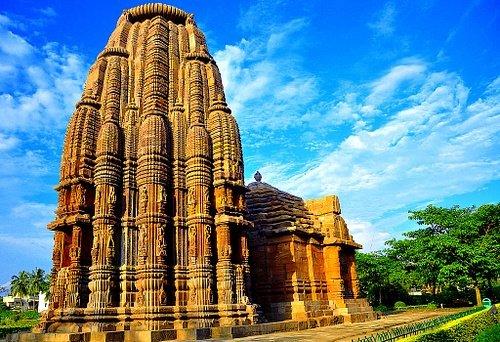Bhubaneshwar (also spelt Bhubaneswar, Bhubanesar, and Bhuvanesvar) is a city located in the Orissa district of north-eastern India and flourished as a centre of Hindu worship from the 7th century CE. Its mass of well-preserved sandstone temples, all oriented around the sacred lake Bindusarowar, make it one of the most impressive ancient temple sites in the whole of India.
Architectural Highlights
The Parasuramesvara & Other Early Temples
Orissan architecture greatly benefitted from a royal marriage between the Western Chalukya rulers and Orissan royalty which brought to the region elements of Gupta architecture and its sophisticated temples. The Orissa then developed this canon into their own distinctive temple style. The oldest structures at Bhubaneswar are probably the three small Satrughnesvara shrines which are set in a line and date to perhaps the late 6th century CE.
The Parasuramesvara temple is of similar date, perhaps a little later, in the early 7th century CE, and built by the Shailodbhava kings. Dedicated to Shiva it has a sikhara (tower, also called deul in Orissan architecture) with a central projecting column on each face. It is topped with a usually large amalaka (ribbed circular stone). The rectangular mukhasala has, again unusually, an entrance at the front and side. The interior is lit with natural light from a row of small apertures in the roof and pierced stone screens. The temple is covered with decorative sculpture of palms, rosettes, and foliage, as well as statues, especially of Kartikeya and Ganesha.
Other early buildings at Bhubaneswar include the Svarnjalesvara, Gauri-Sankara, Mohini, Paschimesvara, and Uttaresvara temples. Two almost identical temples are the slightly later Markandesvara and Sisiresvara. Both have sculpture directly carved from the building stonework, as opposed to later temples when decorative sculpture was carved separately and added later.

The Vaital Deul
The squat Vaital Deul temple, used for tantric worship and dedicated to Chamunda, is located next to the Sisiresvara. The temple was built in the late 8th century CE under the Bhauma Kara kings. It has a two-columned entrance porch and a barrel-vaulted roof (sala) with three amalakas. It is the only structure at Bhubaneswar with figure sculpture in the interior of the garbhagriha (sacred shrine). Indicating the temple's connection with demons and ghosts, these sculptures show Shiva as fearsome Bhairava along with corpses and decapitated heads. The exterior has many kanyas figures – seductive female dancers employed in dressing and beautifying themselves – and a Shiva Nataraja.

The Muktesvara
Built in the 9th-10th century CE under the rule of the Sovamashi, the red sandstone Muktesvara has a square entrance hall (mandapa or jagamohana in Orissa temples) with a tiered (pida) roof. Above the sacred shrine is a tower or sikhara which has amalakas running up the four corners and topped by a single large example, as is typical in Hindu temples across India. On top of the amalaka is a decorative element known as a khapuris, a flat bell-shaped adornment which is topped by either a trident or linga. The tower is punctuated in the middle of each face by protruding crouching lions (dopicchas).
The temple is decorated on the exterior with figures of kanyas, ascetics, and demons all set in individual frames of dots and foliage. Untypically, the ceiling of the mandapa has relief carvings which depict the mythical warrior Virabhadra and the Seven Mothers. The entire building is surrounded by a low wall or parapet carved in relief which has a single ornate gateway with two columns supporting an intricately carved arch. The temple is the greatest example of the mature Orissan architectural style.

The Lingaraja
Built around 1100 CE in the reign of the Ganga kings the massive Lingaraja temple was originally known as the Tribhuvanesvara or the Lord of the Three Worlds, one of the many guises of Shiva. The main temple is composed of four connected chambers: the sacred shrine (deul), entrance hall (jagamohana), dance hall (nata-mandira), and offerings hall (bhoga-mandira). Each supports its own ceiling with four massive pillars. The tower is 45 metres high and even the jagamohana rises an impressive 30 metres. The latter also has two windows with balustrades. Decorative sculpture on the building exteriors includes Yama and Indra in their role as dikpalas (cardinal directions), Ganesha, Parvati, vyalas stamping on elephants, friezes of military episodes, and a multitude of kanyas. The walled compound also contains many subsidiary shrines.
The Rajarani & Other Later Temples
The Rajarani temple was constructed in the 11th to 12th centuries CE in the reign of the Somavamshis on a diamond plan. Similar to temples at Khajuraho, the tower is surrounded by many smaller towers of different heights creating a mass of rising curves. The lower part of the tower is decorated with sculpture of all eight dikpalas (a rarity) and various female figures.
The Brahmesvara was constructed c. 1061 CE and helps to date the Lingaraja on stylistic grounds. The Ananta Vasudeva was built in 1275 CE and is the only major temple at the site which is dedicated to Vishnu. Finally, the Meghesvara was erected in the final quarter of the 12th century CE and has an unusually curved tower.
